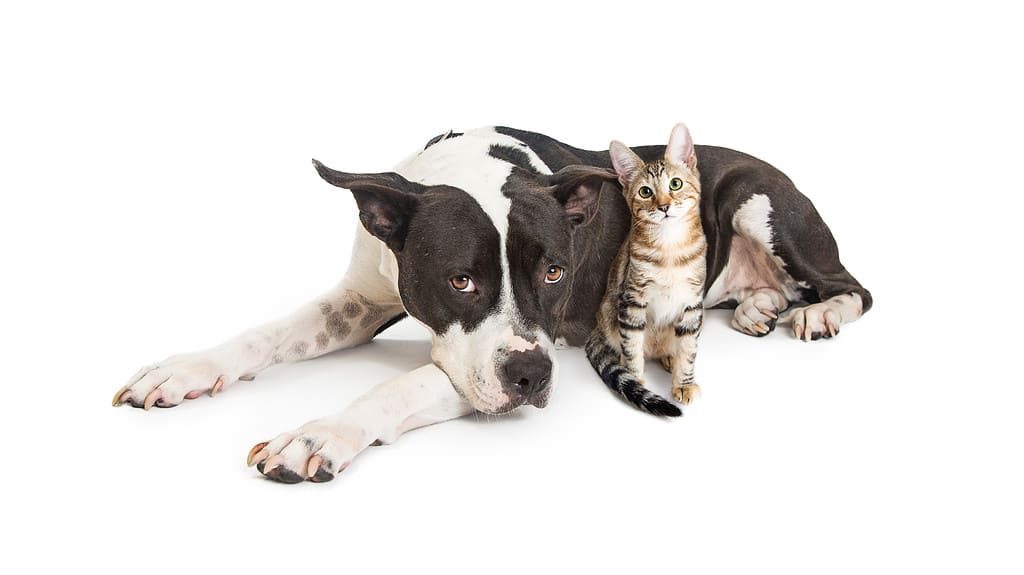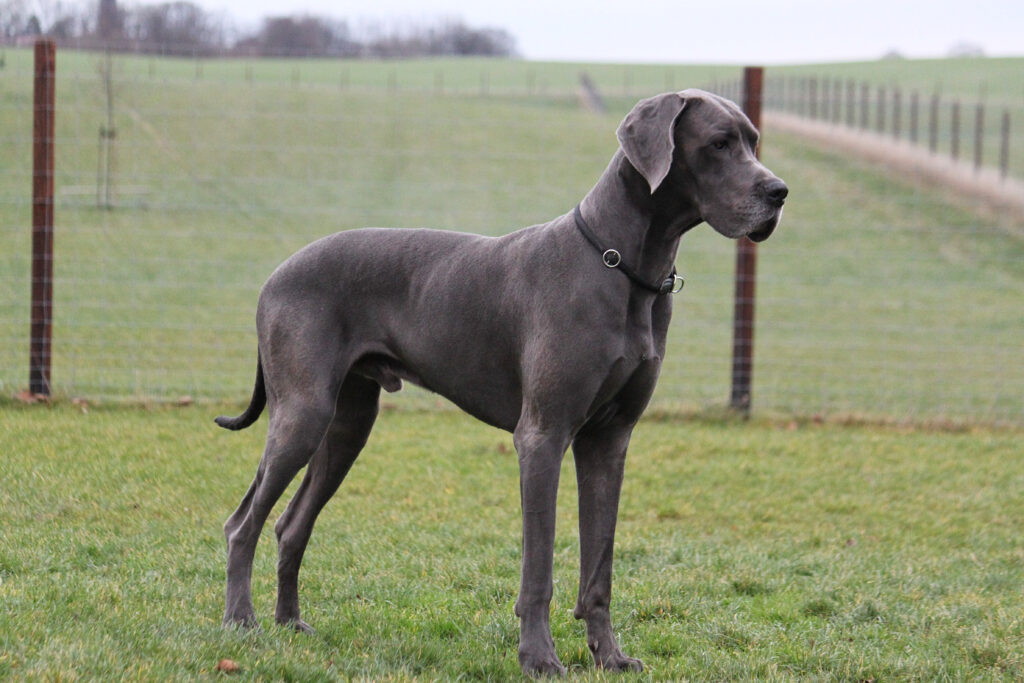A Pit Bull Great Dane mix, or Danebull, is a cross between an American Pit Bull Terrier and a Great Dane. These are muscular, energetic dogs, but they’re actually very different in body shape, size, and temperament.
Pit Bull Great Dane mixes can be either medium or giant in size, with compact or lithe bodies. They may range anywhere from 30-175 pounds. These dogs may be stranger-friendly or territorial, eager to please or aloof, and boisterous or calm. Mixed breeds are often unpredictable in this way.
In this article, we’ll discuss what to expect in a Pit Bull Great Dane mix, where you can find these dogs, and what you can expect to pay for them.
What does a Pit Bull Great Dane Mix Look Like?

Great Danebulls have a variety of coat colors and body shapes depending which parent breed they take after.
©adogslifephoto/iStock via Getty Images
A Pit Bull Great Dane mix can look exactly like a Pit Bull, exactly like a Great Dane, or like a mix of the two. Even in the same litter, puppies may look very different from one another.
Pit Bulls are medium-sized dogs who weigh 30-60 pounds and stand 17-21 inches tall. They have short coats in any color except merle and stocky, compact bodies.
Great Danes are giant dogs. They weigh 110-175 pounds and stand 28-32 inches tall. Danes have lithe but muscular frames. Their short coats may be black, black and white, blue, brindle, fawn, harlequin, mantle, merle, silver, or white.
Grooming a Great Danebull
Great Danebulls will shed a low to medium amount. Their coats are easy to manage and should be brushed once a week.
Because of their short coats, they can be prone to sunburn and skin cancer. They should be kept indoors or in the shade on sunny days and, ideally, will wear doggy sunscreen to prevent damage to their skin.
Other grooming considerations are baths when needed, daily teeth brushing, and nail trims every few weeks.
Temperament: Are Pit Bull Great Dane Mixes Aggressive?

Those who take after their Great Dane parents will have strong protective instincts.
©iStock.com/Credit:BiancaGrueneberg
Like any dog, Pit Bull Great Dane mixes can be aggressive. These are large, powerful dogs, so proper training and socialization is no joke.
Pit Bulls were originally bred for dog fighting, and many Pits don’t get along with other dogs. Great Danes were bred to guard, which can lead to aggression, especially in a dog who isn’t raised well.
A common misconception is that these breeds need a “firm hand,” or someone to be the alpha and make the dogs submit. Aversive training methods and tools promote fear and aggression in dogs, so this myth is actively harmful.
What to Expect from a Great Danebull
Despite their tough reputations and exteriors, these dogs are often incredibly affectionate toward their families. As with all of their traits, Great Danebulls will take from the temperament of both parent breeds.
Pitties are often clingy and stranger-friendly. The United Kennel Club (UKC) notes that human aggression is not standard and dogs with human aggression should not be bred, but there are plenty of bad breeders out there.
For the most part, Pit Bulls are too friendly to make good guard dogs but can make excellent watchdogs. They’re smart, driven, and energetic.
Great Danes also tend to be very lovey toward their people. However, they can be wary of strangers due to their guard dog instincts. Unlike Pits, they were bred to guard and do a great job at it.
They can be independent and stubborn, the opposite of the eager-to-please Pit Bull. They’re intelligent, laid-back, and playful.
How to Train a Pit Bull Great Dane Mix
As we discussed earlier, you should never use aversive training methods or tools on your dog. Punishment-based training promotes fear and aggression and actively hurts your relationship with your pup.
Instead, focus on force-free or relationship-based training methods, also commonly known as positive reinforcement training. This training focuses on using the least aversive methods possible.
They don’t mean never having boundaries or not saying no to your dog. For instance, you wouldn’t let a puppy bite you–but instead of hitting their nose, you’d redirect them to toys or get up and walk away. This teaches them how to play appropriately.
If your dog pees in the house, you wouldn’t push their nose into it or yell at them. Instead, you might make a vet appointment to ensure your dog isn’t ill, adjust the amount of time you expect them to hold it, or go back a few steps to redo their potty training.
Some of the most important things to work on with your Pit Bull Great Dane are manners and socialization.
Remember that socialization doesn’t only mean playing with other dogs or people, but instead teaching your dog how to behave in different settings and around a variety of people and animals. For instance, you can socialize your dog-reactive pup without allowing them to interact directly with other dogs.
How Much Exercise do Great Danebulls Need?
Adult Great Danebulls will need at least 1-2 hours of daily exercise. This can include walks, playtime, and other activities.
Those who take after their Great Dane parent are more likely to chill out after a good round of zoomies in the backyard, while those who take after their Pit Bull parent will be more driven and energetic even after exercise.
Puppies should only be given low-impact activities, and you should be careful not to overexercise them, especially if they take after their Great Dane parent in size. Too much exercise in growing dogs can lead to joint problems.
If you have doubts about your dog’s exercise routine, please speak to your veterinarian. They can tailor their advice specifically to you and your dog, which is especially helpful for mixed breeds.
How Long do Great Danebulls Live?

Dogs who take more after their Pit Bull parents tend to live longer due to their smaller size.
©Anna_Bondarenko/Shutterstock.com
American Pit Bull Terriers live around 12-14 years on average, while Great Danes live just 7-10 years. This discrepancy is mainly due to the size of the dogs since large dogs tend to live shorter lives than smaller ones.
Your mixed breed’s lifespan will depend on their size, genetics, and care. Smaller dogs are most likely to live longer lives, but other factors include genetic health problems, diet, exercise, and veterinary care.
Another way to prolong your dog’s life is to look out after their safety. Pit Bulls can be escape artists and many know how to climb fences, so you’ll want to have fencing that prevents this.
Fences should also be tall enough that your dog cannot jump over them. Great Danes have a strong prey drive, and thus shouldn’t be allowed off-leash in unenclosed areas. They’re fast runners and are prone to getting lost or even hit by cars.
How Much does a Pit Bull Great Dane Mix Cost?
This is an uncommon mix, and I was unable to find puppies for sale. This is actually a great thing, seeing as you’ll rarely find a mixed-breed dog breeder who isn’t a puppy mill or backyard breeder. Most jump on trending mixes and try to maximize their profits, often at the dogs’ expense.
You may find a Pit Bull Great Dane mix at a rescue or shelter. Your best bet will be bully rescues or Great Dane rescues, as they’ll often have mixed breeds.
You might want to expand your search as well by looking into other Pit or Dane mixes.
Thank you for reading! If you have feedback on this post, please contact the AZ Animals editorial team.
The photo featured at the top of this post is © adogslifephoto/iStock via Getty Images
Ready to discover the top 10 cutest dog breeds in the entire world?
How about the fastest dogs, the largest dogs and those that are -- quite frankly -- just the kindest dogs on the planet? Each day, AZ Animals sends out lists just like this to our thousands of email subscribers. And the best part? It's FREE. Join today by entering your email below.
Thank you for reading! Have some feedback for us? Contact the AZ Animals editorial team.







